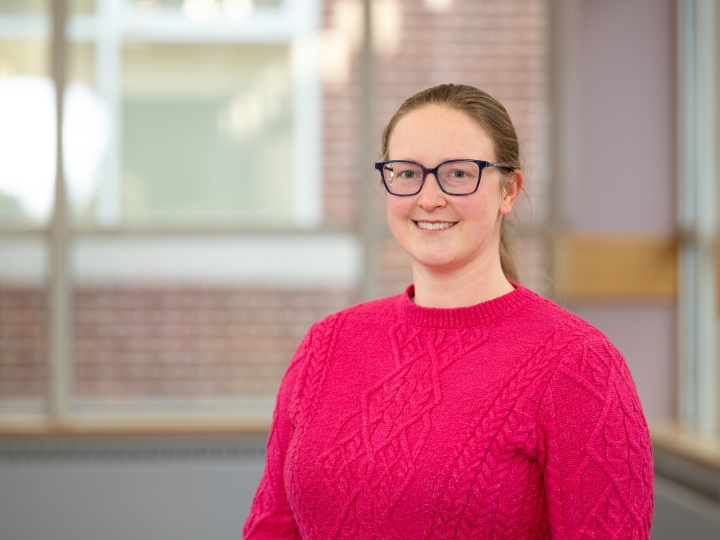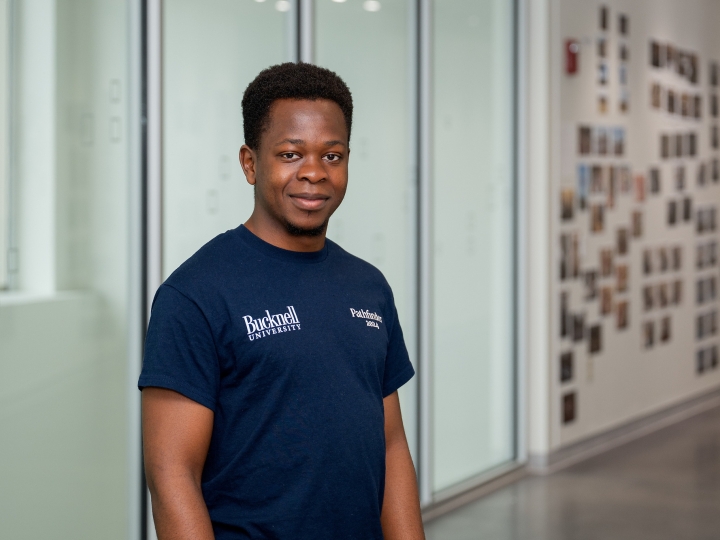Bucknell Students Build App to Get Community Moving — and Learning
October 25, 2017
Sam Greenberg '18 came to Bucknell to study computer engineering, but it was a humanities course that led to his most significant programming achievement yet.
Greenberg is one of more than 10 students with both technical and humanities backgrounds who have helped develop Ready, Set, Fit, a new smartphone app for iOS and Android devices that marries physical fitness with place-based education, with an aim to improve health and quality of life in local communities and beyond. Now available for download, the app is the outcome of a deeply collaborative effort between students and faculty in the humanities and engineering, with support from numerous on-campus and community partners.
The app was still in its formative stages when Greenberg first heard about it in a humanities seminar with Professor Katie Faull, German studies and comparative humanities. While Faull had frequently incorporated technology, especially geographic information systems, in her teaching and research, mobile app development was new territory for her. But Greenberg saw it was in the wheelhouse of his faculty adviser, electrical & computer engineering professor Stu Thompson, so he helped the two professors link up and after two more years of largely student-driven work, the app launched in late September.
"Seeing it get to where it is now is almost surreal," Greenberg said. "It was a fun project that I wanted to get involved with, but I didn't think it would make it as far as it has this quickly and that's been very exciting to me."
Blending Physical Fitness and Place-based Learning
Ready, Set, Fit leverages Google Maps and GPS technology to lead users on guided walking tours. As they pass landmarks along each route, the app displays multimedia content about each stop — on the Bucknell Statue and Sculpture Tour, for instance, users learn the artist, year of installation and other details about eight outdoor art installations along the path's half-mile route. As you travel that route, meanwhile, the app collects data about the distance you walked, the number of steps you took and how long your workout lasted — all of which is displayed when you reach the end of the path. It also tracks cumulative workout data.
"There is absolutely nothing else like it," Faull said. "There are walking and fitness apps and there are tours, but nothing that brings the two together."
Faull, who began work on the project in collaboration with the Geisinger Health System, said the tracking features are important because they can help users make progress toward exercise goals recommended by physicians or wellness programs such as Milton in Motion, an initiative in the town of Milton, 5 miles north of Lewisburg, that partnered with the developers to create a history-themed walking tour. They are also continuing to seek input from local health-care providers.
"We're trying to build ecosystems for its use," Thompson added. "We want to get the medical community involved and help people get fit."
A Student-driven Effort
Bucknell students have played critical roles in all stages of the app's development, from coding to researching and writing app content to working with community members to promote and test the program. Economics major Chase Kravetz '20, for example, has been working with students at nearby Milton Area High School to brainstorm potential content that could attract younger users.
"I think they're interested in it," Kravetz said. "It gives them the opportunity to work with newer technologies that they all use and to create something that they could have on their phones eventually."
History and political science major Austin O'Neil '19, meanwhile, has partnered with the Bucknell University Archives to curate content for campus pathways and is now working with rangers to develop paths at Valley Forge National Historical Park near Philadelphia.
"The app has really come alive for me as people became able to use it this year," O'Neil said. "It's been cool to see the experience people have with it and their reactions to it. A lot of people are interested in this app."
Greenberg, computer science major Caroline Whitman '18 and computer engineering major Jacob Mendelowitz '18 have made more technical contributions, but all said working on the project has still broadened their skills.
"I've learned a whole lot more about technology and realized how technology can intersect with other fields like health and wellness, history and culture," Mendelowitz said. "Bucknell is a liberal arts school with a great engineering program and this has been a great example of what can be realized when students and faculty on both sides work together."
"I learned about the design process of building an app, as well the skills necessary for working on a tech team," Whitman added. "I worked closely with faculty on the project, reminding me of the fantastic opportunities afforded to undergraduate students at Bucknell."
The students have been supported by nearly $35,000 in grants from a variety of sources, including the Degenstein Foundations, the Andrew W. Mellon Foundation, the Foundation for Pennsylvania Watersheds and the Bucknell Center for Sustainability & the Environment, which has also offered logistical support for the project. Nearly all of that funding supported students working on the project over the last three summers through research stipends.
The app contains a dozen paths so far, leading users around campus and through nearby communities including Lewisburg, Milton and Danville. The team is now working on new paths with additional partners, including the Bucknell Office of Admissions and the Pennsylvania Department of Conservation and Natural Resources, which oversees state parks — and is looking for more.
"We're going to continue to evolve the app, because apps that do not have support fade away quickly," Thompson said. "We know that and we're looking for sustainable ways to not only create new paths but evolve the technology as well. And all of that will rely on students continuing to be a part of this."

